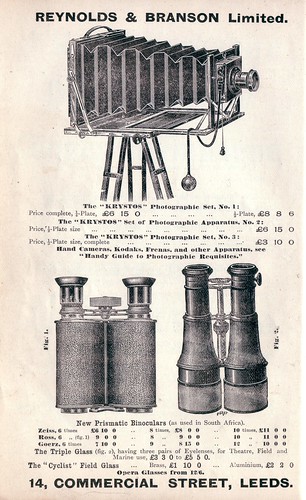Reynolds and Branson
Revision as of 21:12, 22 June 2012 by Dustin McAmera (talk | contribs) (+link to a patent by FW Branson (there are several others, but less interesting))
This article is a stub. You can help Camera-wiki.org by expanding it.

|
| Advertisement from Jackson's Cyclist's Guide to Yorkshire by Tom Bradley, 1900 (Publisher: Richard Jackson, Leeds). Given the date, 'as used in South Africa' may well refer to the Boer War. Scan by Michael Fawcett (Image rights) |
Reynolds and Branson was a company in Leeds, UK, founded in 1816.[1][2] The company had premises in central Leeds, at 14 Commercial Street and 13 Briggate.
The company is generally described as a chemist and optician, but also made general medical equipment and photographic items, including cameras and magic lanterns.
Cameras, etc
- Half-plate tailboard camera, about 1890 [3]
- Whole- or half-plate field camera, about 1890.[1]
- 'Phoenix' shutter: a rather crude shutter, with a hinged flap as the opening blind for each lens, that automatically releases a dropping plate as the closing blind (the 'drop' is accelerated by a tensioned rubber band). The Phoenix was made in both normal mono and stereo models[4][5] Reynolds & Branson patented the Phoenix in 1883, and Branson patented a further development of the shutter on his own.
Notes
- ↑ 1.0 1.1 McKeown, James M. and Joan C. McKeown's Price Guide to Antique and Classic Cameras, 12th Edition, 2005-2006. USA, Centennial Photo Service, 2004. ISBN 0-931838-40-1 (hardcover). ISBN 0-931838-41-X (softcover). p819.
- ↑ Grace's Guide; the entry includes an advertisement for three items: patient record cards, filing drawers for them, and suppositaries!
- ↑ Reynolds and Branson half-plate tailboard camera, about 1890, at Wood and Brass
- ↑ Stereo Phoenix shutter at Early Photography.
- ↑ Mono Phoenix shutter in the catalogue of an exhibition Cameras: the Technology of Photographic Imaging at Museum of the History of Science, Oxford 20 May - 13 September 1997.
Links
- British Patent 16373 of 1893 granted to F.W. Branson, Improvements in or in connection with cameras, describing (i) the use of ribs to strengthen and stiffen the sliding parts of a focusing bed, and (ii) a design for a rack-and-pinion focusing mechanism using racks with teeth cut at an angle and pinions cut in a spiral, to give smoother focusing operation than a conventional rack and pinion; at Espacenet, the patent search facility of the European Patent Office.